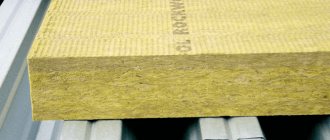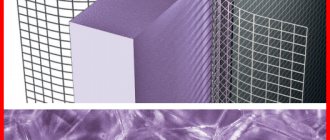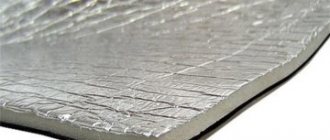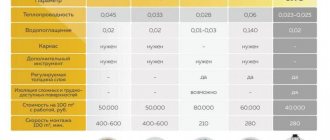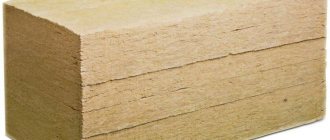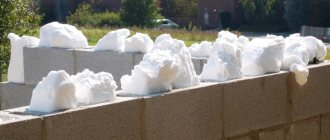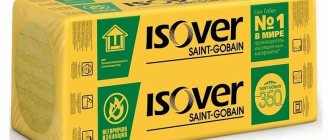In the climatic conditions of central Russia, the problem of thermal insulation is especially acute.
Severe frosts often cause rupture of communication pipes and leakage of much-needed heat from apartments.
To prevent such excesses, a new development from experimental scientists from the Volgograd Innovation Resource Center was presented to the building materials market.
Thermal insulating paint “Armor” for pipes successfully passed the weather tests and became a real breakthrough among products that protect against cold weather.
Composition and properties
Ultra-thin liquid insulation protects metal surfaces from corrosion and helps reduce heat loss from the room. It can be considered a universal option that combines the properties of thermal insulation and paint and varnish materials. Liquid Armor is the result of the development of Russian scientists. The product was presented by the Volgograd Innovation Resource Center. Compound:
- acrylic binder;
- catalysts;
- clamps;
- ceramic microspheres, characterized by ultra-thin walls, they contain rarefied air.
Auxiliary components are special compounds that protect metal structural elements from corrosion, and concrete surfaces from fungus and mold. Bronya insulation has a liquid structure, the consistency resembles paint.
Product color is white. This is ultra-thin thermal insulation. With its help, structural elements made of different materials are protected from heat loss: concrete, metal, etc.
Thanks to the polymer base, the coating becomes elastic after application, which allows it to withstand deformation processes and a small tensile load. Ultra-thin thermal insulation Armor is used as insulation due to the rarefied air that is inside the microspheres. Main characteristics:
- the thermal conductivity coefficient is much lower than that of most analogues and amounts to 0.001 W/(m*C);
- Bronya heat-insulating paint can be used at high and low temperatures: from -60...+250°C;
- does not cause harm to humans, since the composition does not contain highly toxic and volatile compounds;
- fire and explosion safety;
- resistance to aggressive environments, liquid thermal insulation. Armor can come into contact with alkaline mixtures and saline solutions.
Due to its properties, the insulation lasts for a very long time. Its average service life varies from 15 to 30 years. The mixture is called ceramic armor. It can be paint, a liquid mixture, etc., but the structure is the same.
What is liquid thermal insulation?
Liquid thermal insulation, or as it is also called thermal paint, is one of the types of insulation, often used to insulate walls, pipes, roofs, and facades. The consistency of this material resembles mastic or sour cream. This insulation is applied in several thin layers; before applying a new layer, you must wait for the previous one to dry completely. Once dry, each layer will resemble foam, a reaction that occurs due to contact with air.
The base of the thermal paint is usually made of acrylic; it also includes various additives in the form of microspheres of ceramics, glass or silicone. A certain type of additive is suitable for its application. Due to the presence of spheres that contain air, heat is reflected. The presence of acrylic guarantees the durability of liquid thermal insulation.
Application area
Thanks to its excellent characteristics, Bronya insulation is used everywhere. It is used to protect buildings inside and outside. The material is used in the process of insulating communications, insulating wires, etc. The range of application of the mixture is quite wide:
- Protection of vertical and horizontal structural elements of various buildings (floors, walls, ceilings), roofs.
- Possibility of insulating a residential building and large-sized objects, poorly heated premises (hangars, warehouses, workshops).
- Thanks to special additives, the Liquid Armor mixture has anti-corrosion properties and can be used on any metal surfaces.
- Protection of communications of any type from freezing (water supply, sewerage, heating and air conditioning systems, gas and steam pipelines).
- Insulation of the main components of the heating and hot water supply system: boilers, boilers, various types of heat exchangers.
- Oil pipelines that are located below and above soil level.
- This type of thermal insulation is also quite suitable for refrigeration equipment.
- Insulation of water storage facilities and containers for chemical reagents.
- Bronya mixture is used to protect cars (railway, metro) and tanks from heat loss.
- Thermal insulation of ships, boats, yachts and boats (internal surfaces, engine room).
Advantages and disadvantages
When choosing a material with which you can influence the intensity of heat outflow, it is recommended to study the properties and reviews. To select a suitable option from the coatings offered on the market, you should pay attention to the positive and negative qualities of the product. The advantages of the liquid mixture produced under the Bronya brand include the following properties:
- thin layer of coating;
- versatility;
- ease of use;
- the coating does not lose its properties in extreme cold and heat;
- high efficiency;
- the coating does not weigh down the structure;
- excellent adhesion to different types of surfaces;
- the material is non-hygroscopic;
- resistance to UV radiation;
- subject to repair;
- sufficient level of strength.
The material has many advantages. There is a variety of mixtures of this brand:
- for use in winter;
- plastering compounds, etc.
Various types of products are created to protect objects with different characteristics. This means that each option is suitable for use under certain conditions. A significant level of material efficiency is achieved.
The disadvantages include high cost. You can purchase formulations of various types, which are produced under the Bronya brand, for 350-1000 rubles. The price is for 1 liter of liquid. Despite the fact that the material is allowed to be used at temperatures of -60...+250°C, insulation work can only be carried out if the air temperature is above zero. Recommended conditions: +7…+150°С. If you plan to isolate an object for the winter, it is better to do this long before the onset of frost. Disadvantages include drying time. It is allowed to continue work one day after applying the coating.
Overview of coating types
Before choosing a mixture, it is necessary to determine the tasks that you plan to solve with its help. Different materials are created for different conditions. Accordingly, they may differ in properties despite the fact that they have a similar structure. Product range:
- Bronya Classic is a universal composition that is considered basic. It is used for various purposes and is characterized by all the properties of the Bronya thermal insulation material. Available in 5, 10 and 20 liter containers.
- Bronya Standard/Standard N is a budget version of the mixture. It is offered at an affordable price and has a standard set of Bronya thermal insulation properties. At a minimum cost, good protection against heat loss is provided. This mixture is most effective when it is necessary to isolate communications and containers. Option Standard NG is a non-flammable type of material.
- Anticorrosive Thermal insulation, which is applied to the rusted surface, but it is first recommended to remove the loose layer.
- Winter insulation. The composition can withstand low temperatures down to -30°C. It can be applied in any weather conditions, even if it is winter outside.
- Facade paint is a universal mixture, however, it is recommended for use on objects where it is important to ensure vapor permeability. Due to this property, this type of thermal insulation is often used to protect facades.
- Light. The main purpose is the finishing of internal and external surfaces of various types of objects.
- Fire protection is a special composition whose action is aimed at increasing the fire resistance of buildings.
- Universal and Universal NG are an option similar in properties to the mixture of Classic and Standard. At a relatively low price, the protection indicators are high.
- Metal is a simplified but effective version of the Anticor mixture. Offered at a low price.
- The wall is another type that was created as an analogue of more expensive materials. This mixture is similar in properties to the Facade coating. Another option is the Wall NG. It is characterized by fire resistance in addition to the main parameters.
- Nord, Nord NG - a cheap analogue of the Winter mixture.
- Anti-condensation PRO is an effective protection against moisture on various types of surfaces. Typically used for equipment repairs and thermal insulation of communications.
Operating principle
Heat can be transferred in several ways:
- Convection.
- Thermal conductivity.
- Thermal radiation.
Each option is characterized by different principles of heat distribution:
- liquid, gaseous medium
- kinetic energy of the smallest particles
- electromagnetic radiation.
In any of the cases, 2 types of body are involved: one of them is hotter, the other is weaker or completely cold. It is interesting that the insulating material of the Bronya brand to some extent combines 3 methods. The main part of the composition is microspheres filled with rarefied air (80%). The rest of the binder produces heat due to its thermal conductivity property.
The surface receives some of its heat through the process of convection and radiation. Considering that the microspheres contain air, heat loss will be small. This is the most suitable (after vacuum) medium that can be used as an insulator. Due to the low intensity of heat transfer, the material helps maintain the desired temperature of the object.
Heat insulator brands
The manufacturer presents several main options for liquid heat insulation.
Armor Anticor
Effective for insulating metal surfaces.
It can be applied directly to materials that contain signs of developing corrosion processes, without pre-treatment with anti-corrosion substances.
Classic
Bronya Classic is a universal insulating substance that is ideal for processing traditional coatings.
Withstands exposure to elevated temperatures up to 200 °C.
Facade
Bronya Facade - reliably insulates rooms from the inside, without interfering with full air circulation, which avoids the appearance of rot and the formation of fungi.
Armor Winter
The mixture allows you to insulate objects at low temperatures down to -35 oC.
Types of liquid insulation
Types of thermal insulation depending on the purpose
The manufacturer offers several modifications of the product. Each type of composite has a base base and certain additives depending on the purpose of the paint. Options for insulating facades differ from each other in terms of climatic design, where for more severe regions, composites have been developed that are designed for a greater number of cycles of exposure to negative temperatures. Specialized mixtures are more focused on protection against moisture, fungal elements and fire.
Base Coats
The following brands of mastics are produced under the basic ones:
- Classic NG, Classic;
- Facade NG, Facade;
- Anticorrosive;
- Winter NG, Winter.
These are standard modifications of the heat insulator for operation at positive and negative temperatures.
Budget coverings
Thermal insulation for metal pipes is cheaper, but has lower quality characteristics.
Brands of budget composites are represented by the following options:
- Universal NG, Universal;
- Wall NG, Wall;
- Metal;
- Nord NG, Nord.
A series of analogues of basic brands has lower performance indicators and a smaller price niche.
Reviews about ceramic insulation paint
Insulation of communications is one of the intended purposes of ceramic thermal insulation.
There are both good and bad reviews about ceramic insulation. Let's start with the fact that ceramic insulation for walls only works from the inside. There are reviews from real people who claim that this material helped them get rid of mold on the walls, which is a credit to the insulating paint. At the same time, there are a lot of people who are dissatisfied with the use of ceramic thermal insulation on facades. There are even cases when people filed a lawsuit against contractors, since the promised effect of reducing heat loss in the premises was not observed over several years of observation.
A review from the owner of a cottage on one of the respected forums tells that after two years after applying karmic insulation to the walls outside, it was necessary to insulate with mineral wool. The modern method didn't work. Where insulating paint really works:
- pipes;
- metal tanks;
- metal roofs – after this they don’t get so hot;
- walls from the inside - fight against dampness and mold;
- metal structures - as protection against corrosion.
In other words, ceramic thermal insulation is used when there are no options for proper insulation. These are forced measures, and not a full-fledged replacement of the same mineral wool or polyurethane foam. The thermal conductivity of the material is exaggerated; there are no documents that confirm the declared coefficients. And in practice it has already been confirmed that not everything is as advertising presents.
Characteristics of insulation paint Bronya
The composition of the thermal insulation is clearly visible only with an electron microscope.
The developer has endowed the product with the following properties:
- the mass has a uniform white structure;
- the composite has a density of 0.558 g/cm3;
- the structure contains non-volatile substances in a mass ratio of 44%;
- vapor permeability for grades of façade mastics – 0.013 Mg/m h Pa;
- heat transfer coefficient – 1.380 W/m, degrees Celsius;
- thermal conductivity coefficient – 0.0012 W/m, degrees Celsius;
- resistance of the film to water and alkali during the day - the film retains its appearance;
- exposure to negative temperatures over 50 cycles – the film retains its properties;
- adhesion with concrete – 1.33 MPa, with steel – 2.20 MPa, with brick – 2.04 MPa;
- resistance to high temperatures up to 200 degrees Celsius - the film retains its integrity and properties.
The substance in question is not a flammable material and a medium for flame propagation.
Laying technology
The dimensions of most coatings and the non-standard, complex architectural component of modern buildings increasingly make it impossible to effectively use traditional thermal insulation materials both inside and outside. For example, not everyone can thoroughly insulate a curtain wall using mineral wool, especially if the home is located above the second floor.
With the advent of Bronya liquid thermal insulation, the situation has changed dramatically. The substance effectively fills any gaps in structures, creating a coating whose thickness is about 2-3 cm.
Surface preparation
To create a durable, and most importantly, reliable insulating coating, the liquid substance must be applied only after special procedures for preparing the coatings have been completed.
For these purposes, it is recommended to use solvents that have a degreasing effect on surfaces. Finally, it is enough to carefully treat the surfaces with a stiff wire brush.
Application of insulation
The ideal tools for high-quality, effective application of liquid thermal insulation are airless sprayers and soft brushes. During the application of the preliminary layer, no more than 1 mm of the substance is laid. The use of a step-by-step economical approach promotes optimal consumption of thermal insulation, eliminating the formation of layers.
Types of liquid thermal insulation
Liquid thermal insulation can be divided into two large groups. The first group of products includes insulation materials, which are thermal paints, and the second group includes insulation materials with foam filler. Let's look at the features of each group.
- Warm paint
When applied, the thermal paint forms a film that has thermal conductivity. This is ensured by its structure, which contains various fillers. The method of applying it is quite simple and does not differ from coating with regular paint. But one layer will not be enough, because... it can easily wear off or be destroyed by environmental influences. Therefore, for a good thermal effect, at least 10 layers of paint are required. This insulation can be applied to any surface, does not require additional skill, and anyone can handle it. When working inside a building, it is better to use protective masks. The paint dries quite quickly, but several layers are required and during the entire work process you can inhale the chemicals that make up the paint, which can adversely affect your health.
- Foam insulation
In appearance they resemble polyurethane foam. The basis of such thermal insulation consists of a polymer, which upon air contact forms a dense material. It is applied using special spray guns; when applied it appears liquid, but due to its high density it quickly adheres to the material. 30 minutes after application it begins to form a light crust, and after a few hours it begins to harden. This type of insulation is often used by construction companies; it does not have a negative impact on health.
Liquid Armor: how to apply correctly
It is most convenient to use an airless sprayer for liquid insulation. One treatment allows you to apply a millimeter layer of material to the surface. Under such conditions, the consumption of thermal insulation does not exceed the norm, and there is no risk of layering.
It is allowed to carry out thermal insulation work using Armor at temperatures from −35 to +150 degrees Celsius - it all depends on the chosen grade of material. Before processing, the paint is mixed in a container until a homogeneous consistency is formed with a small inclusion of distilled water.
Tips for applying insulation
Before coating any surface, you must thoroughly clean it of dirt, oil stains, fill up potholes and cracks, and then wait until it dries completely. All this will significantly increase the adhesion of Bronya thermal insulation to the material. The paint is applied using a roller, brush or airless spray. The average drying time is 24 hours. It is recommended to apply a layer of no more than 6 mm, since a larger amount will not affect the thermal insulation properties. Water is added to the suspension only in extreme cases, for example, during long-term storage.
Average consumption is 1 liter of Bronya insulation per 1 m2 (with a layer 1 mm thick). The amount of insulation required will vary depending on the surface being painted and the required application density. Judging by the reviews of experts, it is always better to calculate with a reserve, for example, for metal, increase consumption by 5%, concrete - 10%. The temperature of the material to be coated must be in the range from +150 to -35°C. Before use, the thermal insulation should be thoroughly mixed to the same consistency. It is recommended to store only in a hermetically sealed container in a dark room from +40 to -40°C. Transportation is permitted in any way.
Video – Thermal insulation “Armor”. Experimenting with ice
Where is it used?
Liquid heat insulator can be applied to almost all types of surfaces:
- metal,
- brick,
- concrete,
- wood for waterproofing bathroom floors under tiles (written here) and others.
The average paint consumption is 1 liter per 1 sq. meter _ In this case, the layer is approximately 1 mm.
The sequence of work with liquid heat insulator is as follows:
- calculate the required amount of paint to apply. Increase the supply if you have a brick or concrete surface. If there is a relief, the overrun can be up to 35%;
- clean the workpiece . Remove finishing materials, rust, dirt;
- if necessary, prime the surface;
- apply “Armor” of the corresponding brand as the first layer;
- wait until it dries completely . Typically, the next layer should be applied no earlier than 24 hours later;
- apply the next layer . If necessary, repeat paragraphs. 5-6;
- subsequent finishing (if required) is carried out after the last layer has completely dried.
The same steps should be followed when applying paint with a spray gun.
